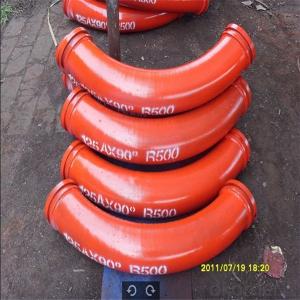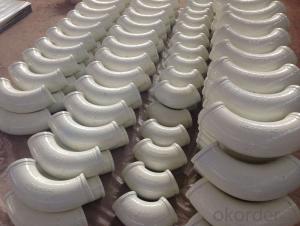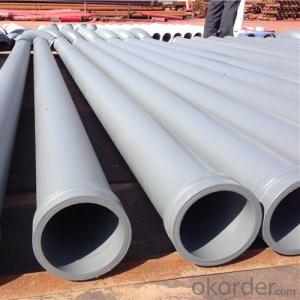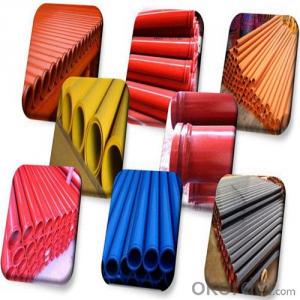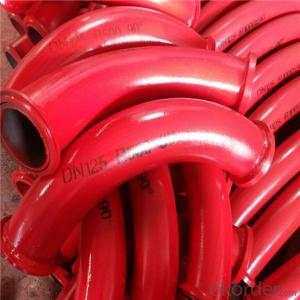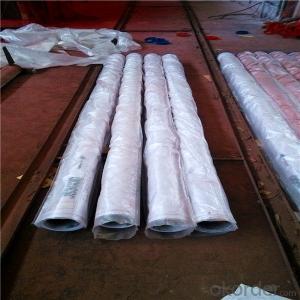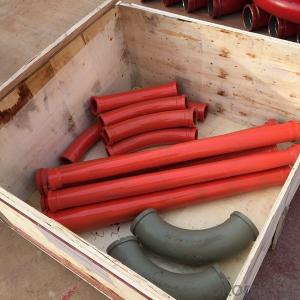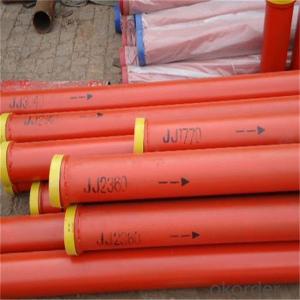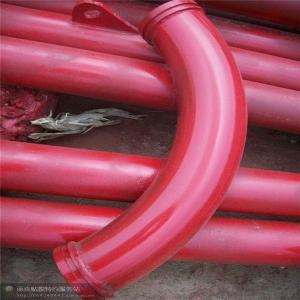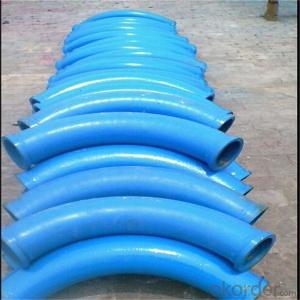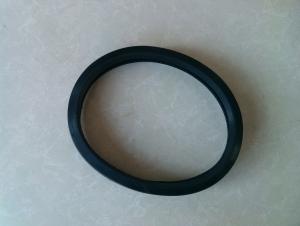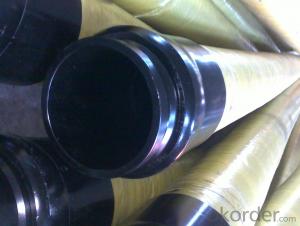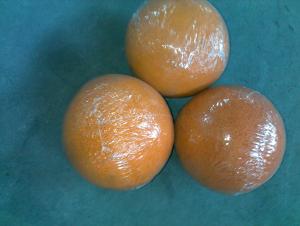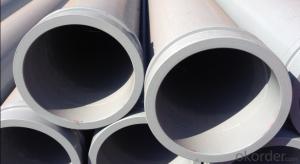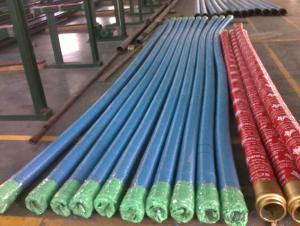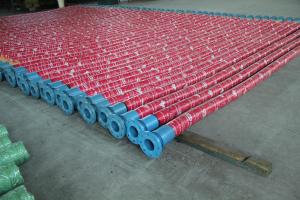Concrete Pump Bend Pipe for Schwing Concrete Pump
- Loading Port:
- Tianjin
- Payment Terms:
- TT OR LC
- Min Order Qty:
- 20 pc
- Supply Capability:
- 2000 pc/month
OKorder Service Pledge
OKorder Financial Service
You Might Also Like
Concrete Pump Bend Pipe for Schwing Concrete Pump
1. Concrete Pump Bend Pipe for Schwing Concrete Pump:
Concrete Pump Bend Pipe for Schwing Concrete Pump is used on concrete pump pipeline for concrete delivery which is much bigger than concrete elbows. It is made by St52 seamless pipe. Now its main structure is as follows;
Material: ST52, 45Mn2 etc.
Flange: ZX, F/M elbow
Size: DN125 etc.
Working Capacity: 25000-45000cbm
Degree: 90, 60, 45, 30 etc.
2. Main Features of Concrete Pump Bend Pipe for Schwing Concrete Pump:
• High Wear-resistant, long service life, lower cost
• In case of quality problem the company provide free replacement.
• Provide technical support for free.
• Provide consumers with regular visits
• Ensure the supply of ancillary parts
• Our company passed the ISO9000 certification, the product through 3C certification in full compliance with national standards.
3. Concrete Pump Bend Pipe for Schwing Concrete Pump Images:
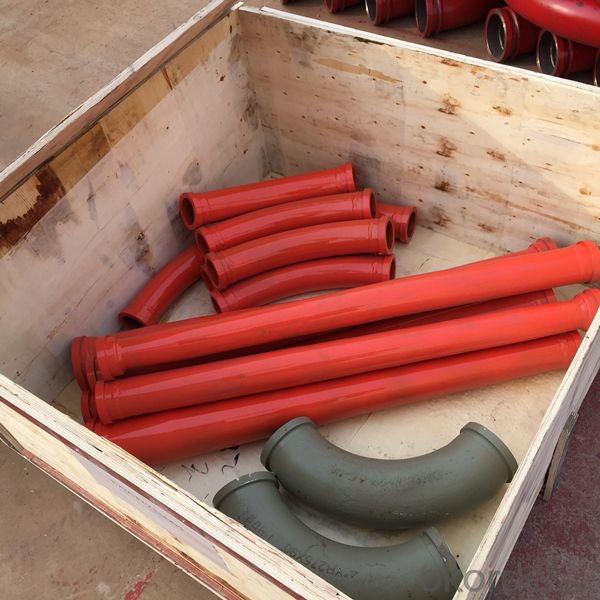
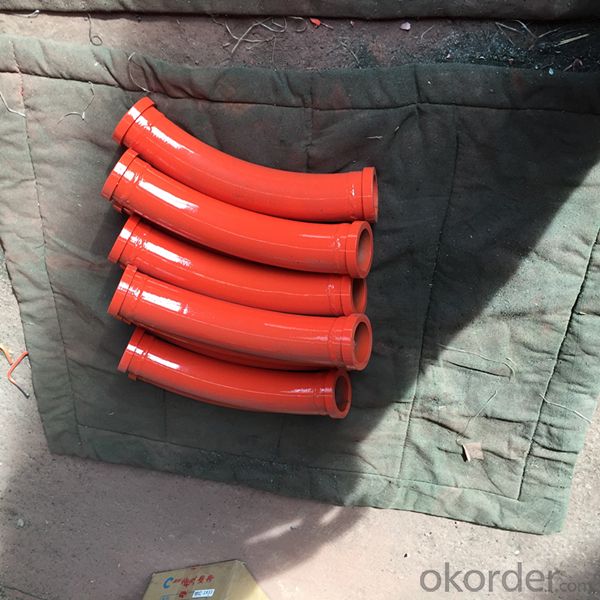
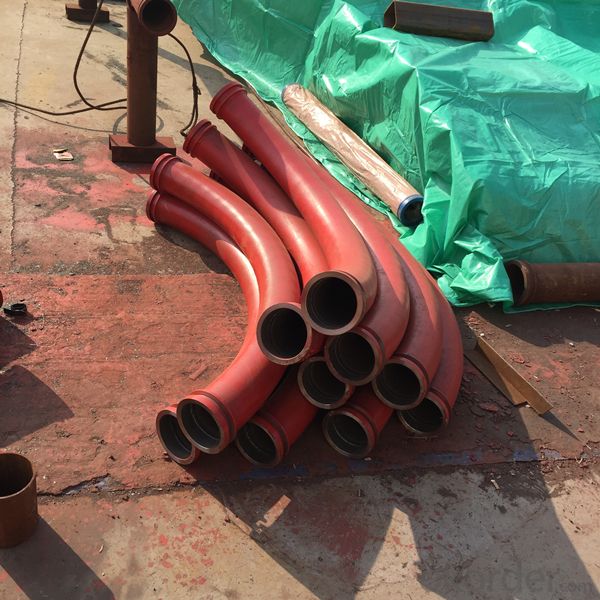
4. Concrete Pump Bend Pipe for Schwing Concrete Pump Specification:
Name | Concrete pump clamp coupling/elbow/pipe/spare parts/gasket |
Standard | Schwing, Putzmeister, Kyokuto, Cifa, Sany, Zoomlion. |
Type | 90O, 60O, 45O,11.5O DN125 {5”}--DN150(6") |
Radius | R275, R180 R320 |
Material | Hi-Mn13,ST52(16Mn), 45Mn2,45#steel and so on |
Usage | Used in Concrete Pump outlet in Construction Work Fit to Schwing and PM, Sany, Zoomlion, Cifa etc.), which include delivery pipe, elbow, reducer, coupling(clamp), male and female flange, rubber hose, cleaning ball, wear plate etc. Welcome to contact us for more information. |
finish | Painting, Epoxy or Galvanization |
Package | Wooden boxes |
Wear-resistant Single or Double Concrete Pump Elbow | |||||||
Type | Singe Elbow | Double Elbow | |||||
Model | DN125 | DN150 | DN175 | DN125 | |||
Material | Casting Steel ,ST52 | Inside | 40Cr | Outside | |||
Size | R275*90° | R275*90°+110 | 36° | F2000 | R275*90° | R275*90°+110 | |
R275*45° | R275*90°+211 | R400*30° | A3000 | R275*45° | R275*90°+211 | ||
R275*25° | R275*90°+411 | R400*45° | 471B | R275*25° | R275*90°+411 | ||
R275*20° | R275*90°+424 | R400*30° | 571B | R275*20° | R275*90°+424 | ||
R275*15° | R275*45°+170 | R488*90° | A1000 | R275*15° | R275*45°+170 | ||
R180*90° | R275*45°+310 | R500*90 | C1000 | R180*90° | R275*45°+310 | ||
R232*60° | R275*45°+310 | R280*90° | B2000 | R232*60° | R275*45°+310 | ||
R240*36° | 20°Lengthen | R240*36° | 20°Lengthen | ||||
R240*30° | 25°+740 | R240*30° | 25°+740 | ||||
R240*15° | 40°Zoomlion | R240*15° | 40°Zoomlion | ||||
R385*29° | R385*29° | ||||||
R315*33° | R315*33° | ||||||
Technic | Forged | ||||||
Average life | 25,000cubic | 50,000cubic | |||||
Application | Used in concrete transport in construction work | ||||||
5. FAQ:
We have organized several common questions for our clients, may help you sincerely:
①Is your products exported a lot?
We have exported to many, many countries. Every year we ship more than 30 containers of these spare parts. Our main market is in Middle-east, Asia & Africa.
②How to guarantee the quality of the products?
We have established the international advanced quality management system,every link from raw material to final product we have strict quality test;We resolutely put an end to unqualified products flowing into the market. At the same time, we will provide necessary follow-up service assurance.
③How long can we receive the product after purchase?
In the purchase of product within three working days, we will arrange the factory delivery as soon as possible. The specific time of receiving is related to the state and position of customers. Commonly 15 working days can be served.
6. Why choose us:
• We are a comprehensive manufacturing and trading company.
• We have been specialized in producing concrete pump spare parts and specialized in producing all kinds of concrete pump parts. As Concrete Pump Pipe, Concrete Pump Elbow, Concrete Pump Rubber Hose, Concrete Pump Wear Plate, Concrete Pump S Valve, Concrete Pump Piston and so on.
• We are famous for our superior quality, competitive prices, first-class craftworks, safe package and prompt delivery.
• We have been supplying concrete pump parts for SCHWING, PUTZMEISTER, SANY, CIFA, KYOKUTO, ZOOMLION for 10 years, so we can promise you the quality and best price.
- Q: What are the specifications for concrete delivery pumps?
- The staff shall not climb or ride on the pipeline, and should be absolutely avoided when working at high altitude
- Q: What is the role of a concrete pump seal?
- The role of a concrete pump seal is to prevent leakage of concrete or other fluids from the pump system, ensuring that the pump operates efficiently and effectively.
- Q: Can concrete pump spare parts be used interchangeably between different pump brands or models?
- Using spare parts from different pump brands or models is not possible due to the specific specifications and dimensions of each pump. The spare parts must be manufactured to fit the requirements of the particular brand and model. Using spare parts from a different brand or model can lead to compatibility problems or even damage the pump. To ensure the pump functions properly and lasts a long time, it is always advisable to use genuine spare parts from the same brand or model.
- Q: What are the indications of a faulty concrete pump seal?
- There are various signs that may suggest a defective seal in a concrete pump. Some commonly observed indications are: 1. Leakage: A clear sign of a faulty seal is the presence of leaks in the seal area. If you notice any leaks, it indicates that the seal is not functioning properly and should be replaced. 2. Decreased pumping efficiency: A defective seal can result in reduced pumping efficiency. If you observe that the concrete pump is unable to deliver the same quantity of concrete as before, or if the job takes longer to complete, it could be due to a faulty seal. 3. Heightened noise levels: Another indication of a faulty seal is an increase in noise levels during operation. If you notice any unusual or louder noises emanating from the concrete pump, it may be an indication that the seal is not sealing properly and requires inspection. 4. Vibrations or movement: Faulty seals can also cause excessive vibrations or movement in the pump. If you notice that the pump is vibrating more than usual or if it moves around during operation, it could signify a problem with the seal. 5. Contamination: A defective seal can allow contaminants like dirt, dust, or water to enter the pump. If you observe any signs of contamination in the pump, it is important to inspect the seal and replace it if needed. Promptly addressing any indications of a defective concrete pump seal is crucial to prevent further damage to the pump and ensure safe and efficient operation. Regular maintenance and inspection of the seal can help in avoiding potential issues and prolonging the lifespan of the concrete pump.
- Q: What are the key factors to consider when purchasing concrete pump spare parts?
- When purchasing concrete pump spare parts, it is important to consider factors such as the quality and reliability of the parts, compatibility with the specific model of the concrete pump, availability and affordability of the parts, as well as the reputation and customer reviews of the supplier or manufacturer. Additionally, factors like warranty, after-sales service, and the durability of the spare parts should also be taken into account.
- Q: Is the main pump of the concrete pump electric control or hydraulic control?
- The main pump behind the oil pump to provide the size of the oil with the greater the current the higher the higher the higher the displacement,
- Q: Can I get spare parts for both single-cylinder and multi-cylinder concrete pumps?
- Spare parts for both single-cylinder and multi-cylinder concrete pumps are readily available. Various manufacturers and suppliers offer a wide range of spare parts for different concrete pump types, including single-cylinder and multi-cylinder models. These spare parts comprise hydraulic cylinders, pistons, seals, valves, hoses, and other crucial components that may require replacement due to wear and tear or damage. To ensure compatibility and availability, it is vital to contact the concrete pump's specific manufacturer or supplier and inquire about the spare parts suitable for your particular model.
- Q: How does the concrete pump work?
- When the pump is in place, support the leg and keep the body level and stable. When feeding with a distributor, the body shall not exceed 3 degrees of inclination
- Q: What is the role of a concrete pump hopper grate pin retainer?
- The role of a concrete pump hopper grate pin retainer is to secure the grate pins in place, preventing them from dislodging or falling out during the pumping process. This helps to maintain the stability and integrity of the hopper grate, ensuring efficient and safe operation of the concrete pump.
- Q: Can I reuse old concrete pump spare parts?
- Yes, old concrete pump spare parts can be reused as long as they are in good condition and meet the required specifications for the pump. However, it is important to properly inspect and test the parts before reuse to ensure they will function safely and efficiently.
Send your message to us
Concrete Pump Bend Pipe for Schwing Concrete Pump
- Loading Port:
- Tianjin
- Payment Terms:
- TT OR LC
- Min Order Qty:
- 20 pc
- Supply Capability:
- 2000 pc/month
OKorder Service Pledge
OKorder Financial Service
Similar products
Hot products
Hot Searches
Related keywords
